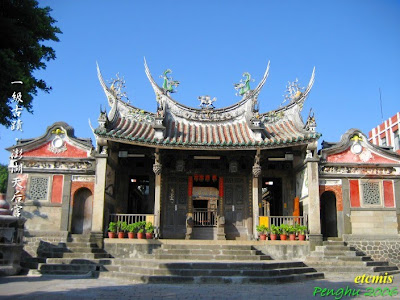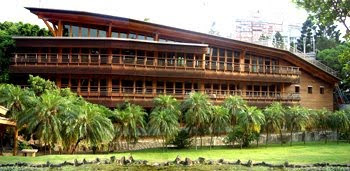The European architectures are still available in Taiwan, namely Fort San Domingo in Danshui and Fort Zeelandia in Tainan which is built respectively by the Spanish and the Dutch during their period of greatest influence on the island.
Japanese styled buildings such the Office of the President, prefecture halls and tree-lined boulevards are still preserved in major cities during the Japanese colonization from 1895 to 1945.
Fort San Domingo
Chinese influenced the architecture in Taiwan through their temples as they are the faith centres for the island’s people and could be found in very village. These structures account for the bulk of the nation’s historic sites, traditional art, and are a key part of Taiwan’s cultural heritage. Renowned ones are Bao-an Temple and Longshan Temple in Taipei, Confucius Temple in Tainan and Mazu Temple in Penghu.
Mazu Temple in Penghu
Chinese architecture are normally found as temples in Taiwan and this is one of the one I visited.

Modern architecture includes skyscrapers such as Taipei 101 and the development towards green buildings such as the Taipei Public Library’s Beitou Branch and exhibition halls._
Taipei "Green" public library
Taipei 101 during countdown!
Taipei 101 during my trip but not during countdown. Only on special occasions then its brightly lid.
Performing Arts:
Music
Dance and music are among the richest legacies of Taiwan's indigenous peoples. Group dances are performed at ceremonies and rituals which consist mostly of simple but harmonious walking and foot-stomping movements which are accompanied by melodic choruses. Indigenous musical instruments include drums, simple stringed instruments, woodwind instruments (flutes), and percussion instruments (rattles and wooden mortars). Their musical culture involves singing and dancing that is closely tied to daily lives with lyrics reflecting all aspects of tribal life, from work, love to drinking and ceremonial occasions and it involve singing in a call-and-response pattern.
A cultural dance performance that I saw in Taiwan

European music started when western church music was first introduced to Taiwan during the Dutch presence in the 17th century and the Spanish who occupied the north of Taiwan around the same period brought with them Catholic mass music and military band instruments. During the Japanese colonial period, Japan having adopted the Westernized educational system had all Taiwanese schools built by the Japanese rulers to conduct Western music classes. This set the platform for Taiwan’s first generation of musicians who studied music in Japan.
The Chinese northern wind music is a general term applied to many genres of music originating in China of the Fujian Province. It includes gong-and-drum music, percussion-and-wind music and music to accompany theatrical performances. It frequently appears in temple ceremonies in Taiwan, such as the Ceremony to Welcome the Goddess of the Sea, various worship rituals and funeral processions.
Taiwan’s popular music has been deeply influenced by the United States and Japan. Songs sung in Mandarin, English and Japanese comprise the mainstream of the pop music market. Under the Kuomintang government, Hokkien language came under pressure and gradually decline as mandarin pop songs became the mainstream.
_
Since the 21st century, various ethnic groups in Taiwan have gradually developed cultural self-awareness and more indigenous songwriters are producing songs sung in their mother tongues. Musical styles in Taiwan today display plenty of cultural diversity by incorporating local ethnic and international musical elements, such as rock ’n’ roll, hip-hop and jazz. This accumulated cultural dynamism has spread influence all across Asia, with many Taiwanese composers and performers, such as A-mei, Jay Chou, Wang Lee-hom, Mayday and F4, gaining prominence with live concerts, CD releases and appearances in movies and TV dramas.
Mandopop singers Jay and Jolin

The music scene in Taiwan is so prominent because parents value culture and tend to sign up their young children for music lessons, thus, improving the technical skill level of Taiwanese musicians. In addition, most Taiwanese teenagers spend their time practicing their singing skills at karaoke as an recreation activity.
Opera
Taiwanese opera was the only native-born theatrical form in Taiwan. It was hidden at different times for political reasons. In the 1900s, Taiwanese opera was invented through the combination of folk songs with earlier dramatic forms, which became a well-liked form of entertainment. As it developed, it continued to absorb elements from many other styles of Chinese theatre and music.

Puppetry
Glove puppetry was introduced to Taiwan by immigrants from the China’s Fujian Province for more than 200 years ago. Different puppet masters began to add other types of music to glove puppet performances, such as Beijing opera, Japanese pop, Western, and Taiwanese opera music. It broke away from its original wooden stages and evolves into “golden light” puppetry and televised glove puppetry through electronic sound and lighting effects. During the process of change and development, glove puppetry was transformed into a unique style of Taiwanese drama possessing Taiwanese cultural characteristics. It is a combination of the different aspects of culture, such as various dialects, folk music, carving, colour painting, embroidery, and puppet manipulation techniques.
Traditional Taiwanese puppet

Televised puppetry is different through the use of brilliant special effects. Taiwanese glove puppetry is a drama that is deeply rooted in Taiwanese folk society. In the previous generation, it served as the Taiwanese people’s best channel of recreation and relaxation. Today, though no longer Taiwan’s most significant activity, it continues to adjust to the changing trends to offer a stunning and appealing drama.
TV puppetry, these puppets are worth thousands of dollars and are deeply appreciated by the Taiwanese.
_
Food
_
Eating is an art and a cultural expression to the Taiwanese. Taiwan’s extremely diverse food culture was contributed by the various immigrants who settled in the region and, because of historical and political reasons. The Kuomintang government and its troops’ retreated to Taiwan brought plenty of chefs from all parts of China with them. These culinary masters brought their knowledge of regional styles with them, and many opened restaurants, giving the Taiwanese a whole new range of dining alternatives.
_
Influence on Taiwanese seafood cuisine came from Japan during the colonisation with focus on the culinary tradition of raw materials being the most important. However, Japanese food is served with a local style, giving it a Taiwanese flavour. For example, toro in Japan is usually served raw but in Taiwan there are many different ways of cooking the toro such as steamed, fried with black pepper or grilled.
_
In distinction to the superior dishes served at formal restaurants are a wide variety of local foods known as Xiao-chi are somewhat like a delicacy, snack, or one dish of a main meal. These are local dishes fused with the taste of the countryside. The more popular Xiao-chi are stinky tofu, O-a-tsian (oyster omelette), pearl milk tea, suncake, iron eggs, small sausage wrapped in big sausage and pig blood cake and they are the speciality of different regions in Taiwan.
Ah Zhong Mian Xian where all tourist and locals queue for a delicious bowl of vermicelli and eat it piping hot while standing up!

Stinky Tofu

But it taste quite Yummy actually!

Literally translated, its called small sausage wrapped in large sausage, the name seem so intriguing, however it tasted awful. 
These are called iron eggs, very unique in taste and texture.
Pearl Milk Tea (the original)
Oyster Omelette
The picture of the one I ate looked so awful that I decided to google and present a nicer one!

Religion
Taiwan practices freedom of religion, big-heartedly accepting foreign religious ideas while honouring traditional beliefs. It is common for different faiths to exist even within the same family. The indigenous Taiwanese tribes traditionally worship nature. Protestant Christianity was introduced via missionaries to the Taiwanese with the arrival of the Dutch in 1624. Two years later, Catholicism was introduced to Taiwan when the Spanish arrived. Shinto was brought to Taiwan during the Japanese colonial period in 1895. Buddhism and Taoism were brought by the Chinese immigrants to the island over a few centuries of immigration and settlement.
Taiwan is a country of diverse religious beliefs and there are currently thirteen registered religions on the island. Practiced by nearly half of the residents of Taiwan, Buddhism which originated from India was introduced to Taiwan in the late 16th Century is practiced most among the Taiwanese. Taoism which evolved from the philosophy of Lao Tzu, who lived during the 6th Century BC, is the second most popular religion in Taiwan. The central idea of Taoism is the fulfilment of divinity and Taoists use incense for prayer and worships.
The mass tour packages to Taiwan normally includes a lot of visits to different temples because the majority religion is Buddhism and they build temples at almost every city, state....

Inside Taiwanese temples, rituals are frequently performed to seek help from the gods. Devotees burn three sticks of incense before an altar as they mentally repeat their name, birth date, address, and the question they would like to ask the god. Two crescent-shaped divining blocks, made of wood or bamboo, are dropped onto the floor and the position of the wooden blocks would determine the god’s answer. Drawing lots in Taiwanese temples is another way to seek guidance from the gods. A large number of wooden strips placed in a cylindrical container is shaken and drawn out. The divining blocks are then used to check for the right strip and the devotee chooses the paper prophesy according to the bamboo strip. Some temples have professional interpreters to help infer them as they are rather vague.


























































